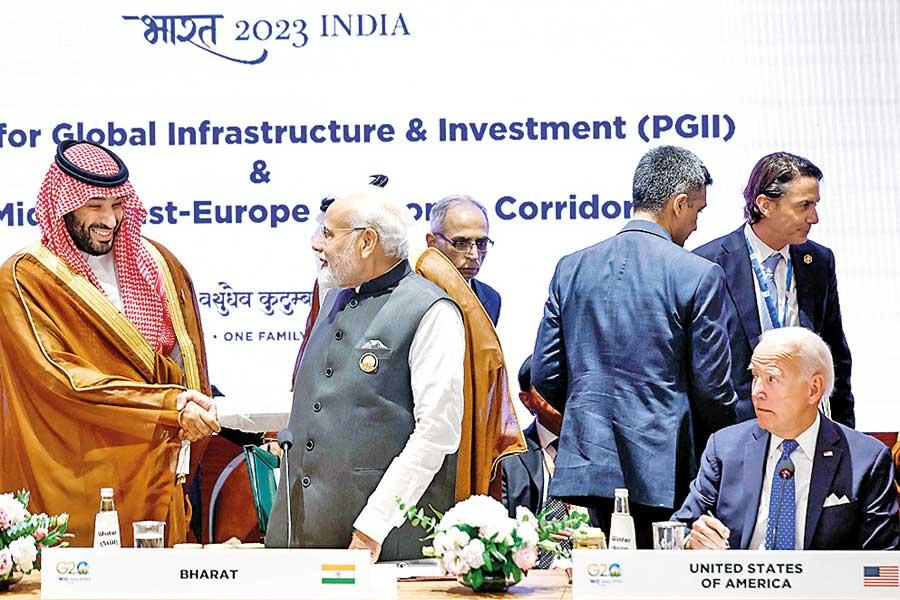15 Sep 2023 - {{hitsCtrl.values.hits}}

On the sidelines of the G20 summit, Saudi Arabia’s Crown Prince and Prime Minister Mohammed bin Salman (L), Indian Prime Minister Narendra Modi (2L) and US President Joe Biden (R) attend the event to announce the IMEC, the proposed economic corridor. AFP
 A new connectivity plan that might compete with or complement China’s One-Belt-One-Road initiative or the Belt-and-Road initiative (BRI), depending on how geopolitics play out, emerged on the sidelines of the recently finished G20 meeting in New Delhi.
A new connectivity plan that might compete with or complement China’s One-Belt-One-Road initiative or the Belt-and-Road initiative (BRI), depending on how geopolitics play out, emerged on the sidelines of the recently finished G20 meeting in New Delhi.
One year after it was unveiled at the G20 summit in Bali, Indonesia, the Partnership for Global Infrastructure Investment (PGII) agreement was launched last Saturday in New Delhi. It aims to create a multibillion-dollar corridor linking India (South Asia), the Middle East, and Europe (IMEC).
The signatories were the EU, India, Saudi Arabia, the United Arab Emirates, the US and other G20 partners, except China, Russia, Argentina, Brazil, Canada, Indonesia and Mexico. The countries that did not sign the deal do not belong to the territory the corridor will cover. The corridor will link India, Saudi Arabia, the United Arab Emirates, Jordan, Israel and the EU through shipping ports and rail routes. Its stated objective is to make trade quicker and cheaper and boost economic cooperation and digital connectivity across the region.
The unstated objective, however, is one of geopolitics and great power rivalry. The New Delhi deal seeks to strengthen the Western alliance working to check China. It also gives a fillip to the United States President’s ambitious dream of normalising ties between Arab Gulf nations and Israel.
On the one hand, the IMEC suggests that more than one belt and one road may be necessary to link economic powerhouses and advance international trade. On the other hand, the IMEC points to an emerging global order with geopolitical significance and both bipolar and multipolar features.
Some nations now have the option to either choose one of the corridors or subscribe to both. It is said that Italy is now considering leaving the BRI.
During the South Asian Association of Regional Cooperation (SAARC)’s active days, India had been promoting a South Asian connectivity plan. With SAARC now in a coma, India has been pushing for greater connectivity with friendly neighbours, including Sri Lanka.
One may say that the more corridors, the merrier. Trade corridors and connectivity will bring nations together through closer, interdependent trade ties. Certainly, trade promotes peace, but only if it is pursued without geopolitical agendas.
But can this be said of the IMEC, which United States President Joe Biden hailed as a “really big deal” and “game-changing investment”? It appears to have been conceived in bad faith vis-à-vis China. If the new corridor was meant to complement the BRI, it should have included China. After all, both China and India share a 3,488-kilometre-long border. If trade alone is the focus of the IMEC, it should have roped in China.
It goes without saying that an IMEC with China will be a much more powerful economic power than an IMEC without China. India has spurned China’s BRI on the grounds that part of the China-Pakistan Economic Corridor (CPEC) is going through Pakistan-administered Kashmir, which India claims as its territory.
If China had been included in the IMEC, the new corridor, by linking with the BRI, could have emerged as a gigantic network for world trade and world peace. Moreover, it would have eased geopolitical tensions between China and India. But it was not to be.
Most analysts see the IMEC as a US-led effort to counter China’s BRI and promote Washington as a trusted investor for infrastructure projects in developing nations, especially in those countries that have subscribed to the BRI only to be embroiled in a debt problem.
Describing the new corridor as a political tool, China’s Communist Party-run newspaper, Global Times, however, cast doubts about the IMEC’s success, given the low volume of trade the corridor’s rail network will carry between the regions it covers. The Global Times also says the IMEC project will not make economic sense if it squeezes out China.
“Who can actually believe that the US-led IMEC is intended to promote cross-regional economic integration or regional development and prosperity? The geopolitical underpinnings of the project could not be more obvious. The US is trying to squeeze China’s influence out of the Middle East and relevant regions by building large economic corridors as a counterweight to the BRI,” the newspaper said in its editorial on Monday.
Of late, China has been making inroads into the Middle East, with the biggest feather in its cap being the Iran-Saudi Arabia rapprochement it mediated, bringing in its wake a series of peace moves leading to the de-escalation of tensions in the Middle East, but posing a challenge to the US influence in the region.
Biden’s national security adviser Jake Sullivan said, “We think that the project itself is bold and transformative, but the vision behind the project is equally bold and transformative, and we will see it replicated in other parts of the world as well.”
The fact that the US national security advisor has stepped in to hail the project underscores the geostrategic significance of the new project.
Already, the IMEC has run into some issues. The member states have not reached an agreement on who will fund how much of this US$600 billion project. Will the Gulf states be coaxed to cough up the dollars? Fuller plans will be out in two months.
Meanwhile, Turkish President Recep Tayyip Erdogan, though a signatory, has expressed doubts about the IMEC’s viability. After his return from the G20 summit, he ran down the IMEC and, instead, promoted the Iraq Development Road Project, which aims to connect the Gulf Arab countries to Turkey and Europe through a railway and highway via ports in the UAE, Qatar, and Iraq.
The looming corridor politics is an indication that the international political order is moving towards a complex system of bi-multipolarity, a term coined by international relations expert Richard Rosecrance in the 1960s. The term bi-multipolarity means a fusion of the bipolar world and the multipolar world.
Today’s multipolarity is seen in the emergence of various security, geopolitics and economic blocs such as the G7, G20, BRICS, NATO, the European Union, the BRI, the new IMEC, and, not to mention, the two quads—one involving the US, India, Japan and Australia and the other the US, India, Israel and the United Arab Emirates.
In today’s multipolar world, nations find themselves in groupings and alliances that also include nations they consider rivals or foes. BRICS and the G20 are fine examples. Moreover, the de-dollarisation vision of BRICS, in which India is a key founding member, is an economic security issue for the United States, with whom India has formed an alliance to check China’s assertive moves in the Indo-Pacific region.
But this multipolarism is overshadowed by the growing bipolarity seen in the global conflict between a loose China-led alliance comprising, among others, Russia and North Korea, and the West-led alliance, which includes several Asian powers such as India, Japan, South Korea, and Australia. The West-led alliance fears a China-led global order and is in a relentless campaign to thwart it. Hence, we witness the gradual emergence of a bi-multipolar global order.
27 Dec 2024 3 hours ago
27 Dec 2024 3 hours ago
27 Dec 2024 4 hours ago
27 Dec 2024 4 hours ago
27 Dec 2024 5 hours ago